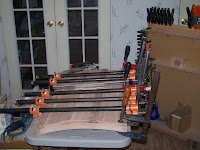No, no… that’s not some sort of sadistic hair removal method; I’m referring to the legs for their tables.
 The process involves this jig I built, a power sander and a respirator. The jig and the portable vise hold a leg so I can run the sander over the upper face in one long uninterrupted sweep. Otherwise there’s not much to say. The purpose here is to remove milling marks, fuzzy bits, pencil lines and knock off the sharp corners. More refinement will be done when I do the finish sanding.
The process involves this jig I built, a power sander and a respirator. The jig and the portable vise hold a leg so I can run the sander over the upper face in one long uninterrupted sweep. Otherwise there’s not much to say. The purpose here is to remove milling marks, fuzzy bits, pencil lines and knock off the sharp corners. More refinement will be done when I do the finish sanding.  As I get the matched pairs sanded I go ahead and install the pivots so they stay matched up. For those that will not be stained I also pre-finish the area inside the pivot joint. This way I can be sure there will not be any unfinished wood left hiding inside the joint after I shoot the tables with the HVLP spray gun… those pivot points can be pesky this way.
As I get the matched pairs sanded I go ahead and install the pivots so they stay matched up. For those that will not be stained I also pre-finish the area inside the pivot joint. This way I can be sure there will not be any unfinished wood left hiding inside the joint after I shoot the tables with the HVLP spray gun… those pivot points can be pesky this way. Once the sanding was done on all of these I turned again to Mikes walking stick. And quickly ran into a problem. The tool rest I have is only 6 inches wide. The stick I’m turning is about 30” long. Normally, if turning a spindle or post this is not an issue, I just move the rest along and work on one section at a time. But here I’m to turn a long, smooth taper; no beads, coves, or any features of any sort just a taper from 1” diameter at one end to just under ¾” diameter at the other end. Getting this long of a taper smooth and even would be much easier to do with a wider tool rest. So I went on-line to look for one at my usual tool stores. They all carry the lathe, but no tool rests. Humph! I’ll work on ferreting out one of these this weekend; I should have plenty of time.
Once the sanding was done on all of these I turned again to Mikes walking stick. And quickly ran into a problem. The tool rest I have is only 6 inches wide. The stick I’m turning is about 30” long. Normally, if turning a spindle or post this is not an issue, I just move the rest along and work on one section at a time. But here I’m to turn a long, smooth taper; no beads, coves, or any features of any sort just a taper from 1” diameter at one end to just under ¾” diameter at the other end. Getting this long of a taper smooth and even would be much easier to do with a wider tool rest. So I went on-line to look for one at my usual tool stores. They all carry the lathe, but no tool rests. Humph! I’ll work on ferreting out one of these this weekend; I should have plenty of time.Tomorrow (Friday) is my day at Treasures, and Saturday I'm standing in for somone who just had surgery so the shop will be closed until Monday.
Hope you have a great weekend!
Doug














































